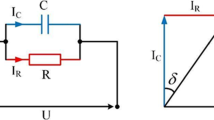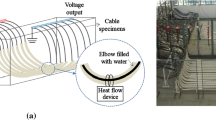Abstract
Charge (Q–t) characteristic plays a significant role in the insulation undergoing irreversible aging condition of the cable. In this study, the pulse voltage is used as a diagnostic method based on water tree detection. The mechanism of residual charge accompanied in the degraded insulation part using Maxwell–Wagner model by numerical analysis is performed. The charge intensity of healthy and degraded cable for an approximate model of 6.6 kV and the actual model of 66 kV single-core, XLPE insulated cable was considered for simulation analysis. The effect of DC voltage, peak pulse voltage, and a number of pulses on the amount of charge was the subject of our research. The residual charges were increased, which indicates the severely degraded conformity in the tested cable compared with the conventional method. Moreover, the effect of ‘fast pulse’ 4 ns wide and ‘slow pulse’ 1.5 ms wide has been applied and its behavior is quantitatively assessed by simulation test using an actual cable model. Various studies have emphasized using this pulse and identification to seek electrical current signals associated with the water-treeing region. The ‘fast pulse’ signal generates an oscillatory response, contains a 143–585 pC charge, and the ‘slow pulse’ signal generates a non-oscillatory response containing 2.4–9.5 μC charge originate at the water treeing region.

















Similar content being viewed by others
References
Zhang Y, Wu K, et al (2018) Non-debye dielectric behavior of aged XLPE cable insulation. In: IEEE International Conference on the properties and applications of dielectric materials, pp 435–438
Priya S, Gowri Sree V (2021) Estimation of electric field force density in water-treed XLPE insulation under variable frequency AC Voltage. In: International Symposium on devices, circuits and systems, pp 1–4. https://doi.org/10.1109/ISDCS52006.2021.9397906
Oonishi H, Urano F, Mochizuki T et al (1987) Development of a new diagnostic method for Hot-Line XLPE cables with water trees. IEEE Trans Power Deliv PWRD-2(1):1–7
Uchida K (2002) Necessity of cable diagnosis from the viewpoint of electric power companies. In: IEEE/PES transmission and distribution conference and exhibition, vol 2. pp 1406–1410
Kim H-J, Park J-S, Mun J, Kim D-H, Hwangbo S, Yi D-Y, Byun J-K (2021) Sensitivity analysis of water tree and input pulse parameters for time-domain reflectometry of power cables using taguchi method. J Electr Eng Technol 16:633–642. https://doi.org/10.1007/s42835-020-00591-7
Thomas AJ, Saha TK (2008) A new dielectric response model for water tree degraded XLPE insulation—part a: model development with small sample verification. IEEE Trans Dielectr Electr Insul 15(4):1131–1143
Karhan M, Çakır MF, Ugur M (2021) A New approach to the analysis of water treeing using feature extraction of vented type water tree images. J Electr Eng Technol 16:1241–1252. https://doi.org/10.1007/s42835-021-00667-y
Densley J, Hvidsten S, Boone W, et al (2012) Non-destructive water-tree detection in XLPE cable insulation. Working Group CIGRE. JWG D1/B1.20
Ahmed M, AI-Ohali MA et al (1999) Analysis of water trees in underground HV cables using the KFUPM micro-PIXE facility. IEEE Trans Dielectr Electr Insul 6(1):95–99
Li W, Zheng W et al (2021) A comparative study on the insulation ageing of 10 kV XLPE cable via accelerated electrical test and accelerated water tree test. J Electr Eng Technol. https://doi.org/10.1007/s42835-021-00817-2
Ozaki R, Masaki S, et al (2014) Polarity-reversed voltage pulse propagation analysis for power cable insulation diagnosis. In: International Symposium on electrical insulating materials, pp 461–464
Al-Hamouz Z, Soufi K, et al (2015) Electrical diagnostic techniques to assess water trees in Extruded Underground Power Cables. https://www.researchgate.net/publication/266474658. Accessed 13 Sep 2020
Dorris DL et al (1996) Current pulses during water treeing: procedures and results. IEEE Trans Dielectr Electrl Insul 3(4):523–528
Hvidsten S, Ildstad E et al (1998) Understanding water treeing mechanisms in the development of diagnostic test methods. IEEE Trans Dielectr Electr Insul 5(5):754–760
Takahashi T, Kurihara T, Okamoto T (2020) Deterioration characteristics of electrical insulation performance for 60kV class decommissioned XLPE cable manufactured dry-curing process. IEEJ Trans Power Energy 140(4):299–304. https://doi.org/10.1541/ieejpes.140.299
Densley J (2001) Ageing mechanisms and diagnostics for power cables—an overview. IEEE Electr Insul Mag 17:14–22
Plsplrls CS (2001) Cable diagnosis. In-situ tests with returned voltage diagnosis method in Romania. In: 16th international conference and exhibition on electricity distribution, 2001. Part 1: Contributions. CIRED. (IEE Conf. Publ No. 482), vol 1. p 10. https://doi.org/10.1049/cp:20010721
Suenaga K et al (2008) Location of water tree degraded point along XLPE cable line using DC voltage. In: international conference on condition monitoring and diagnosis, pp 1224–1227. https://doi.org/10.1109/CMD.2008.4580509
Lima FN, Finazzi AP, Carvalho BC (2016) A comparative analysis of loss current obtained by measuring circuits used in studies of degradation power cables. In: International Conference on renewable energies and power quality, pp 312–317. https://doi.org/10.24084/repqj14.301
Tsujimoto T, Nakade M et al (2003) Development of on-site diagnostic method for XLPE cable by harmonics in AC loss current. In: International conference on properties and applications of dielectric materials, vol 1. pp 73–76. https://doi.org/10.1109/ICPADM.2003.1218356
Bhumiwat SA (2010) Interpretation of dielectric spectroscopy results in time and frequency domains for power cables. In: CIGRE paper D1–216, vol 43. pp 22–27
Ootaka I, Aoki M et al (2006) Direct-detect Type residual charge method with short-term voltage up-down for water tree deterioration diagnosis in XLPE cable. IEEJ Trans Power Energy 126(4):452–459
Ootaka I, Aoki M et al (2008) On-site application and improvement of water tree deterioration diagnosis for XLPE cable by residual charge method. In: International conference on condition monitoring and diagnosis, pp 311–314. https://doi.org/10.1109/CMD.2008.4580289
Ra N, Futami H, et al (2017) Study on charge dynamics in water-tree XLPE insulation for deterioration diagnosis. In: International symposium on electrical insulating materials, vol 1. pp 343–346
Kurihara T, Okamoto T et al (2017) Evaluation of the relationship between residual charge signal and AC breakdown strength of water-tree degraded 22 to 77 kV classes XLPE cables removed from service using pulsed voltages. IEEE Trans Dielectr Electr Insul 24(1):656–665
Futami H, Ra N, et al (2017) Study on short time charge behavior in pulsed residual charge method for water tree diagnostics of XLPE cables. In: International symposium on electrical insulating materials, vol 2. pp 559–562
Ra N, Yamane R, Futami H, Kawashima T, Murakami Y, Hozumia N (2019) Assessment of charge behavior in water tree-degraded cables under pulse voltages. IEEJ Trans Electr Electron Eng 14:1126–1132. https://doi.org/10.1002/tee.22909
Chen Qi, Burkes K, Makram E, Hadidi R, Xufeng Xu (2014) Capacitance of water tree modeling in underground cables. J Power Energy Eng 2:9–18. https://doi.org/10.4236/jpee.2014.211002
Du BX, Huo ZX, et al (2009) Water tree deterioration diagnosis for 10 kV XLPE cable based on residual charge method. In: International Conference on properties and applications of dielectric materials, pp 417–420. https://doi.org/10.1109/ICPADM.2009.5252400
Wang W, Sonoda K et al (2018) Current integrated technique for insulation diagnosis of water-tree degraded cable. IEEE Trans Dielectr Electr Insul 25(1):94–101
Shahul Hameed KM, Joseph J, Sindhu TK (2016) Detection of location and size of water tree in XLPE cables by frequency response analysis: a simulation study. In: IEEE region 10 conference, pp 622–626. https://doi.org/10.1109/TENCON.2016.7848077
Stancu C, Plopeanu MG, Notingher PV, Grigorescu S (2012) Lifetime estimation method of polyethylene power cables insulation subjected to electric field in the presence of water. In: 13th International conference on optimization of electrical and electronic equipment, pp 143–150. https://doi.org/10.1109/OPTIM.2012.6231788
Acknowledgements
The authors gratefully acknowledge Tamilnadu Generation and Distribution Corporation Ltd., (TANGEDCO) for providing cable samples.
Author information
Authors and Affiliations
Corresponding author
Ethics declarations
Conflicts of interest
The authors declare no conflict of interest.
Additional information
Publisher's Note
Springer Nature remains neutral with regard to jurisdictional claims in published maps and institutional affiliations.
Rights and permissions
About this article
Cite this article
Selvamany, P., Varadarajan, G.S. Understanding of Pulse Voltage Response Analysis for Degradation in XLPE Cable Using Equivalent Circuit Model. J. Electr. Eng. Technol. 17, 2951–2962 (2022). https://doi.org/10.1007/s42835-022-01071-w
Received:
Revised:
Accepted:
Published:
Issue Date:
DOI: https://doi.org/10.1007/s42835-022-01071-w




